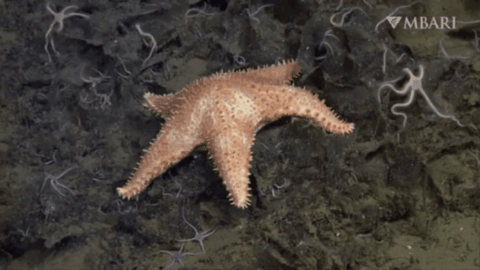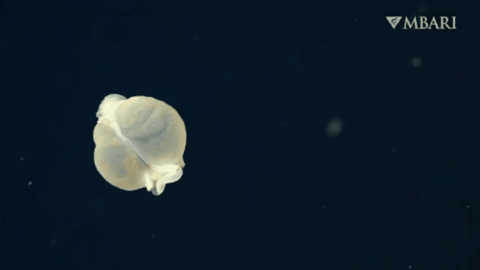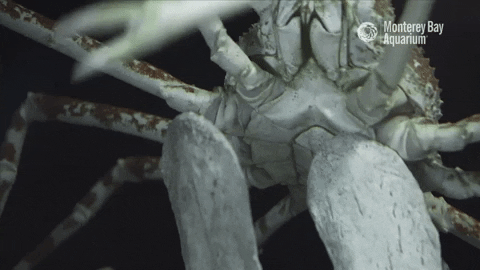Text
Shining a light on the origins of bioluminescence ✨✨
A new study led by MBARI collaborators at the Smithsonian’s National Museum of Natural History explores the evolution of bioluminescence, nature’s living light show. A team of researchers, including MBARI Senior Scientist Steven Haddock, has learned bioluminescence first evolved in animals at least 540 million years ago in soft corals.
Scientists have long been curious about the evolution of bioluminescence. To tackle the larger question of why bioluminescence evolved, we needed to know when this ability first appeared in animals. In search of the trait’s earliest origins, the team decided to peer back into the evolutionary history of octocorals, an ancient and frequently bioluminescent group of animals that includes soft corals, sea fans, and sea pens.
Mapping out the branches of the evolutionary tree from fossil records, genetics, and bioluminescent behaviors revealed that some 540 million years ago, the common ancestor of all octocorals was very likely bioluminescent. That is 273 million years earlier than the glowing ostracod crustaceans that previously held the title of earliest evolution of bioluminescence in animals.
MBARI’s Biodiversity and Biooptics Team is working to understand how and why animals produce their stunning luminescence.
Learn more about this illuminating research on our website.
89 notes
·
View notes
Text
youtube
Too often, MBARI’s advanced underwater robots encounter trash.
Even miles beneath the ocean’s surface we find garbage, much of it plastic. Plastic pollution puts deep-sea animals at risk. On the seafloor, bags and other plastic trash can smother marine life. In the midwater, drifting debris can entangle or choke animals or damage their delicate structures.
Over time plastic trash breaks down into smaller and smaller bits and pieces called microplastic. Microplastics have been found throughout the ocean, from the surface to the seafloor. We still don't understand how microplastics are impacting marine communities. MBARI research is revealing our close connection to the ocean—how it sustains us and how human actions affect marine animals and environments.
To protect the amazing animals of the deep, we need to stem the tide of plastic pollution. Single-use plastic items—like water bottles, takeout containers, coffee lids, straws, and shopping bags—make up a large percent of plastic waste. By refusing plastic packaging and choosing reusable alternatives, we can make a significant dent in ocean plastic pollution. Learn more about trash in the deep sea on our website.
Learn what you can do from MBARI’s education and conservation partner, the Monterey Bay Aquarium.
76 notes
·
View notes
Text
We get pretty excited about the common siphonophore. What’s not to love?
We’re thrilled to be the first public aquarium in the world to culture and raise these delightful drifters. While these animals are incredibly fragile and difficult to see, they’re abundant and can be found throughout the ocean!
Siphonophores are colonies of tiny animals called “zooids”, and they play an important role in the oceanic food webs.
Thank you to our colleagues at @mbari-blog for the common siphonophore footage! Check out their website to learn more about these magnificent mysteries!
2K notes
·
View notes
Text
A deep-sea coral's secret weapon against hungry predators—sweeper tentacles.
A bamboo coral’s stony branches contain thousands of tiny polyps living and working together. The individual polyps stretch feathery tentacles into the currents to grasp plankton and other particles of food drifting in the currents.
When predators like nudibranchs and sea stars try to make a meal of a coral’s polyps, the colony can put up a fight. These fleshy sweeper tentacles are loaded with powerful stinging cells that gently sway along the base of this shaggy bamboo coral (Isidella tentaculum) to keep predators from crawling up to eat those precious polyps.
Learn more about these captivating corals on our website.
140 notes
·
View notes
Text
youtube
With a puffy and prickly body, the spiny star (Hippasteria sp.) is easy to spot on the deep seafloor.
These stars roam the seafloor searching for a delicious dinner, and a hungry Hippasteria can be quite particular when it comes to feeding. For some, sea pens or anemones are their sole preference. Here in our backyard, spiny stars seek out prey that is particularly prevalent in the Monterey Bay and beyond: deep-sea corals.
While some corals have evolved protective stinging sweeper tentacles to deter hungry predators, spiny stars are determined in their quest for a nutritious feast. They use tiny tube feet to scale a towering coral. When they find a good spot to stop, they wrap their arms around the stalk to hang on tight, then extrude their stomach out of their mouth to devour the juicy coral polyps.

Hippasteria are important in restructuring the habitats where they live. As they leave dead coral skeletons behind, homes for new animals are created. This natural turnover keeps the community healthy and helps foster diversity among the fishes and invertebrates that live there.
Animals that live deep in the ocean thrive in cold water and high salinity. Changes in climate at the surface ripple down to the depths below. Warmer and more acidic waters put deep-sea corals—and the animals that depend on them for food and shelter—at risk.

Studying the animals of the deep is increasingly urgent. Overfishing, pollution, and climate change all threaten the deep ocean. What we learn in the field and in the lab improves our baseline understanding of deep-sea communities so we can assess and track ongoing human impacts on the animals and habitats far beneath the ocean’s surface.
Learn more about the spiny star and other fascinating animals of the deep at our Animals of the Deep gallery.
61 notes
·
View notes
Text
Sit back and enjoy 10 relaxing minutes at the Octopus Garden
youtube
Deep below the ocean’s surface, just off the Central California coast, thousands of pearl octopus (Muusoctopus robustus) gather near an extinct underwater volcano. MBARI and a team of collaborators used high-tech tools to monitor the Octopus Garden and learn exactly why this site is so attractive to these animals. After three years of study, researchers confirmed that Muusoctopus gather at the Octopus Garden to mate and nest in cracks and crevices bathed by deep-sea thermal springs.

This site is the largest known aggregation of octopus anywhere in the world, with more than 20,000 octopus nests. The abundance of other marine life that thrives there underscores the need to understand and protect hotspots of life on the deep seafloor from threats like climate change and seabed mining.
#deep relax ocean#ocean#octopus#octopus garden#deep sea#deep ocean#marine life#marine biology#nature#science#Youtube
172 notes
·
View notes
Text
These deep-dwelling fish can see through their own foreheads.
Even in a world full of adaptations for seeing in near-total darkness, the barreleye fish (Macropinna microstoma) stands out as one of the most bizarre. Two small indentations where eyes might normally appear on a fish are actually the barreleye’s olfactory organs, and its eyes are two glowing green orbs behind its face that gaze up towards the top of its head.
In 2009, MBARI researchers showed that the fish can rotate its eyes towards the front to see its food when eating. Before that, scientists believed that the barreleye’s gaze was fixed looking straight up. Researchers think that the fish hovers below a siphonophore’s tentacles to steal food.
291 notes
·
View notes
Text
Spectacular seafloor finds. 💜
This is Psychropotes longicauda, one of the sea cucumber species commonly observed at MBARI’s research site Station M. These sea cucumbers grow from 75 to 150 millimeters (three to six inches) long and feed on detritus that drifts down from surface waters. This group of sea cucumbers is found worldwide in very deep waters ranging from 2,000 to 6,000 meters (6,560 to 19,685 feet). Although they have the ability to swim, researchers aren’t exactly sure what the large fin is used for in this species.
Long-term studies at Station M have revealed that this species of sea cucumber seems to prefer eating older detritus that has been partially decomposed by bacteria. The observations made over the last three decades of research at Station M provide a glimpse into the dynamics of life on the ocean floor.
250 notes
·
View notes
Text
Meet MBARI: The Video Lab is the team at the heart of our stunning deep-sea video
youtube
In 36 years of deep-sea discoveries, MBARI’s remotely operated vehicles have completed more than 7,300 successful dives and recorded approximately 29,000 hours of deep-sea footage. The MBARI Video Lab team is at the heart of this treasure trove of visual data. This video archive includes more than 10 million observations about what we see on video—animals, behaviors, interactions, geological features, marine debris, and more—along with location, depth, and surrounding habitat characteristics.
Video is a powerful tool for studying the ocean. Cameras on MBARI’s advanced underwater robots help our scientists discover remarkable new species, describe communities, and assess ocean health. We’ve amassed a unique archive of deep-sea video that’s essential for research groups across the institute and beyond. The Video Lab’s deep-sea experts comb through thousands of hours of footage with eagle eyes to identify and label animals and objects we film.
MBARI’s video library is a rich repository for education and outreach too. The Video Lab works closely with the Science Communication Team to produce videos and create other content that utilizes these invaluable archives to tell compelling stories about our research.
44 notes
·
View notes
Text
One fish, two fish, red fish, blue fish
This deep-sea anglerfish is Chaunacops coloratus, related to one of the new species recently found in Chile on Schmidt Ocean Institute’s #SEPacificSeamounts expedition. In 2012 MBARI researchers were the first to publish observations of these rare fish in their natural, deep-sea habitat. In addition to documenting these fish walking on the seafloor and fishing with their built-in lures, the researchers discovered that the fish change color from blue to red as they get older.
C. coloratus was first described from a single specimen collected off the coast of Panama during an expedition in 1891. However, for over 100 years, marine researchers collected deep-sea fish using trawl nets and dredges, so this anglerfish was never seen alive. That changed in 2002, when researchers from MBARI, Moss Landing Marine Laboratories, and the Monterey Bay National Marine Sanctuary used the remotely operated vehicle (ROV) Tiburon to explore Davidson Seamount—an extinct volcano off the coast of Central California.
As a result of MBARI’s ROV observations, researchers also learned that C. coloratus can live as deep as 3,300 meters (11,000 feet) below the ocean’s surface. Given the great depths these fish inhabit, it is no surprise that they had never before been seen alive. It is a testament to the usefulness of ROVs, which have provided marine scientists with a new window into the deep sea. MBARI has pioneered the use of ROVs to study animals, discover new species, document previously unknown behaviors, and collect individuals in their native habitat.
349 notes
·
View notes
Text
I spy with my little eye something giant floating in the deep.
The bell of this deep-sea denizen is more than one meter (3.3 feet) across and trails four ribbon-like arms that can grow more than 10 meters (33 feet) in length. Their depth range is the surface to 6,700 meters (4 miles) deep. MBARI’s ROVs have logged thousands of dives, yet we have only seen this spectacular species nine times.
The giant phantom jelly was first collected in 1899. Since then, scientists have only encountered this animal about 100 times. It appears to have a worldwide distribution and has been recorded in all ocean basins except for the Arctic. The challenges of accessing its deep-water habitat contribute to the relative scarcity of sightings for such a large and broadly distributed species.
588 notes
·
View notes
Text
This curious critter is a worm like no other: The pigbutt worm
youtube
Bobbing along in ocean currents a half mile below the surface is a worm like no other. Our team first spotted the unusual pigbutt worm (Chaetopterus pugaporcinus) in 2001 and had a tough time determining how to categorize such a curious critter. Working closely with our collaborators, DNA analysis eventually confirmed we had encountered a new species of bristle worm that drifts through the midwater instead of living on the seafloor.

Over the last two decades, these worms have only been observed in Monterey Bay and a few near the Channel Islands off the southern California coast. This little worm is about the size of a hazelnut, and even using our high-resolution cameras, it took the eagle eyes of our expert biologists to spot these miniature orbs in the massive ocean. Our skilled submersible pilots were able to gently sample them and transport them back to the ship alive for detailed examination.

Chaetopterus pugaporcinus casts out a web of snot to capture bits of organic material called marine snow to eat. Mucus is a useful substance for snaring food in the deep sea where it may be sparse. Numerous other animals get their nutrition this way too. Animals of all shapes and sizes in the ocean perform an essential climate service by taking up excess carbon dioxide from the atmosphere and transporting it deep in the ocean. These assorted midwater mucous-feeders help repackage carbon to sink more rapidly to hungry seafloor communities.
153 notes
·
View notes
Text
Ready to embrace the sea-crets of the deep?
Uncover your enchanting aquatic alter ego by taking our new deep-sea personality quiz here!






Thank you MBARI for the deep-sea footage!
17K notes
·
View notes
Text
Meet Helicocranchia, the piglet squid.
This species is found throughout the world’s tropical and subtropical oceans and, in the Atlantic Ocean, in north temperate waters. Their mantle reaches a maximum size of 10 centimeters (nearly four inches). Like other glass squids, they covered in tiny pigment sacs called chromatophores. They often keep their chromatophores closed so their skin is basically see through. This invisibility cloak hides them from both predators and prey.
Glass squids have a large internal cavity they fill with ammonium, a chemical that is lighter than seawater. Building a more buoyant body means the squid does not have to swim as hard to stay afloat. They maneuver slowly through the midwater with their fins, constantly on the lookout for danger or a delicious meal.
518 notes
·
View notes
Text
Red siphonophore (Marrus claudanielis)
Meet Marrus claudanielis, the red siphonophore. These siphonophores have a maximum size of 30cm (12in). Like many siphonophores, Marrus live their entire lives swimming and never touching the seafloor. They are found between 500m (1,640ft) and 1,500m (4,920ft) deep.
Red siphonophores capture prey with a curtain of potent stinging cells. They are ethereal and delicate organisms, readily jettisoning body parts when threatened. The cast-off swimming bells are bioluminescent and likely function to confuse predators, but this trait also makes them particularly challenging to study. This species was first described by MBARI researchers and their collaborators using ROV video observations and careful collections.
334 notes
·
View notes
Text
What's not to love about the bloody-belly comb jelly?
Its crimson colors and dazzling diffraction have us swooning all year long. 😍😍😍
🎥: Deepest thanks to our research partners @mbari_news for the deep-sea footage!
3K notes
·
View notes
Text
Our love for the ocean runs deep. ❤️
Bloody-belly comb jellies are ctenophores. Like other comb jellies they navigate through the water by beating their shimmering hair like cilia. The sparkling display we see in this video clip comes from light diffracting from these tiny transparent cilia.
At the depths where this comb jelly lives it’s nearly invisible to predators and prey because the color red appears black and allows the animal to blend into the dark background. These twilight zone treasures are found in the North Pacific Ocean and measure about 6 inches across. You can see one for yourself on display @montereybayaquarium .
453 notes
·
View notes